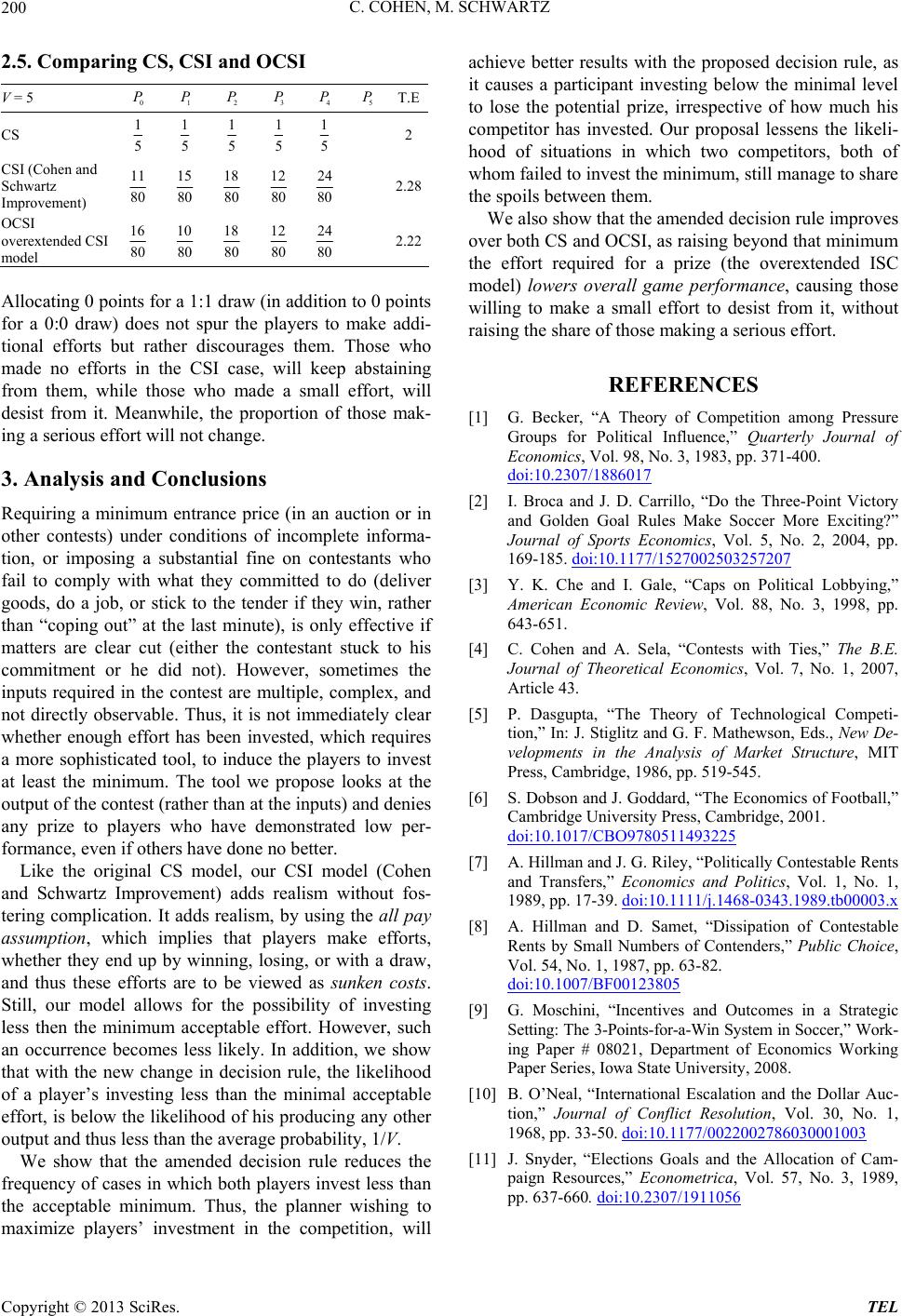
C. COHEN, M. SCHWARTZ
Copyright © 2013 SciRes. TEL
200
2.5. Comparing CS, CSI and OCSI
V = 5 0
P 1
P 2
P 3
P 4
P 5
PT.E
CS 1
5 1
5 1
5 1
5 1
5 2
CSI (Cohen and
Schwartz
Improvement)
11
80 15
80 18
80 12
80 24
80 2.28
OCSI
overextended CSI
model
16
80 10
80 18
80 12
80 24
80 2.22
Allocating 0 poin ts for a 1 :1 draw (in add ition to 0 po ints
for a 0:0 draw) does not spur the players to make addi-
tional efforts but rather discourages them. Those who
made no efforts in the CSI case, will keep abstaining
from them, while those who made a small effort, will
desist from it. Meanwhile, the proportion of those mak-
ing a serious effort will not change.
3. Analysis and Conclusions
Requiring a minimum entrance price (in an auction or in
other contests) under conditions of incomplete informa-
tion, or imposing a substantial fine on contestants who
fail to comply with what they committed to do (deliver
goods, do a job, or stick to the tender if they win, rather
than “coping out” at the last minute), is only effective if
matters are clear cut (either the contestant stuck to his
commitment or he did not). However, sometimes the
inputs required in the contest are multiple, complex, and
not directly observable. Thus, it is not immediately clear
whether enough effort has been invested, which requires
a more sophisticated tool, to induce the players to invest
at least the minimum. The tool we propose looks at the
output of the contest (rather than at the inputs) and denies
any prize to players who have demonstrated low per-
formance, even if others have done no better.
Like the original CS model, our CSI model (Cohen
and Schwartz Improvement) adds realism without fos-
tering complication. It adds realism, by using the all pay
assump tion, which implies that players make efforts,
whether they end up by winning, losing, or with a draw,
and thus these efforts are to be viewed as sunken costs.
Still, our model allows for the possibility of investing
less then the minimum acceptable effort. However, such
an occurrence becomes less likely. In addition, we show
that with the new change in decision rule, the likelihood
of a player’s investing less than the minimal acceptable
effort, is below the likelihood of his producing any other
output and thus less than the average probability, 1/V.
We show that the amended decision rule reduces the
frequency of cases in which both players invest less than
the acceptable minimum. Thus, the planner wishing to
maximize players’ investment in the competition, will
achieve better results with the proposed decision rule, as
it causes a participant investing below the minimal level
to lose the potential prize, irrespective of how much his
competitor has invested. Our proposal lessens the likeli-
hood of situations in which two competitors, both of
whom failed to invest the minimum, still manag e to share
the spoils between them.
We also show that the amended decision rule improves
over both CS and OCSI, as r aising beyond that minimu m
the effort required for a prize (the overextended ISC
model) lowers overall game performance, causing those
willing to make a small effort to desist from it, without
raising the share of those making a serious effort.
REFERENCES
[1] G. Becker, “A Theory of Competition among Pressure
Groups for Political Influence,” Quarterly Journal of
Economics, Vol. 98, No. 3, 1983, pp. 371-400.
doi:10.2307/1886017
[2] I. Broca and J. D. Carrillo, “Do the Three-Point Victory
and Golden Goal Rules Make Soccer More Exciting?”
Journal of Sports Economics, Vol. 5, No. 2, 2004, pp.
169-185. doi:10.1177/1527002503257207
[3] Y. K. Che and I. Gale, “Caps on Political Lobbying,”
American Economic Review, Vol. 88, No. 3, 1998, pp.
643-651.
[4] C. Cohen and A. Sela, “Contests with Ties,” The B.E.
Journal of Theoretical Economics, Vol. 7, No. 1, 2007,
Article 43.
[5] P. Dasgupta, “The Theory of Technological Competi-
tion,” In: J. Stiglitz and G. F. Mathewson, Eds., New De-
velopments in the Analysis of Market Structure, MIT
Press, Cambridge, 1986, pp. 519-545.
[6] S. Dobson and J. Goddard, “The Economics of Football,”
Cambridge University Press, Cambridge, 2001.
doi:10.1017/CBO9780511493225
[7] A. Hillman and J. G. Riley, “Politically Contestable Rents
and Transfers,” Economics and Politics, Vol. 1, No. 1,
1989, pp. 17-39. doi:10.1111/j.1468-0343.1989.tb00003.x
[8] A. Hillman and D. Samet, “Dissipation of Contestable
Rents by Small Numbers of Contenders,” Public Choice,
Vol. 54, No. 1, 1987, pp. 63-82.
doi:10.1007/BF00123805
[9] G. Moschini, “Incentives and Outcomes in a Strategic
Setting: The 3-Points-for-a-Win System in Soccer,” Work-
ing Paper # 08021, Department of Economics Working
Paper Series, Iowa State University, 2008.
[10] B. O’Neal, “International Escalation and the Dollar Auc-
tion,” Journal of Conflict Resolution, Vol. 30, No. 1,
1968, pp. 33-50. doi:10.1177/0022002786030001003
[11] J. Snyder, “Elections Goals and the Allocation of Cam-
paign Resources,” Econometrica, Vol. 57, No. 3, 1989,
pp. 637-660. doi:10.2307/1911056